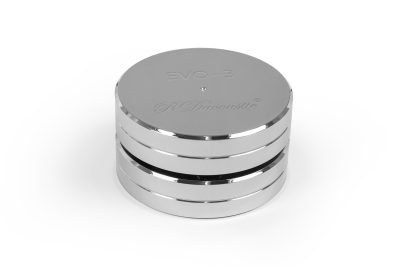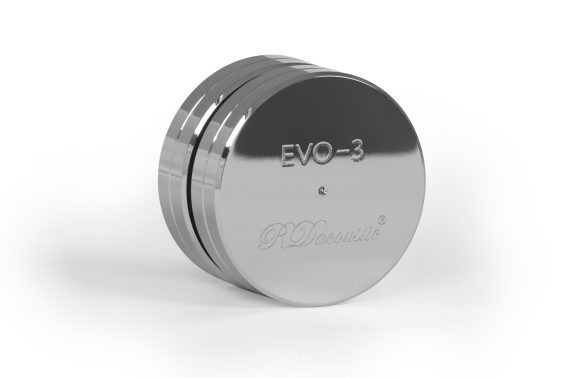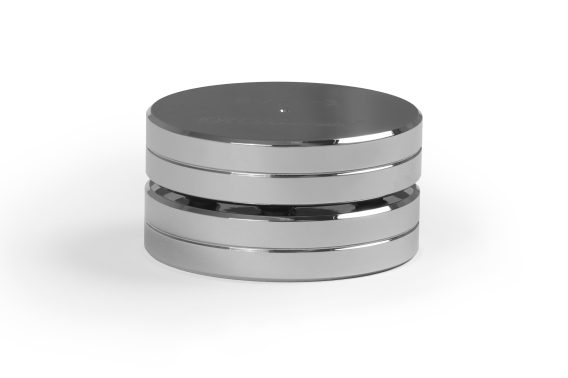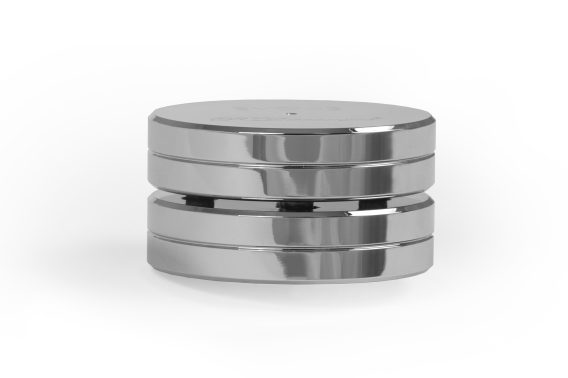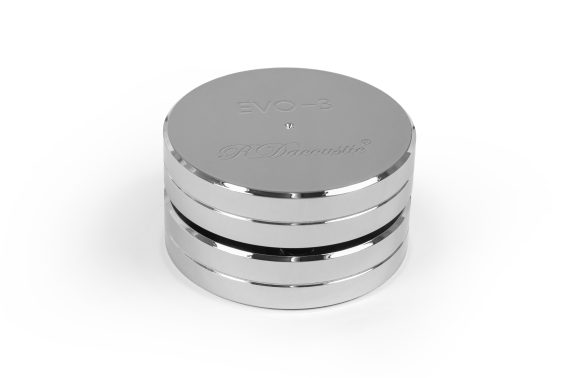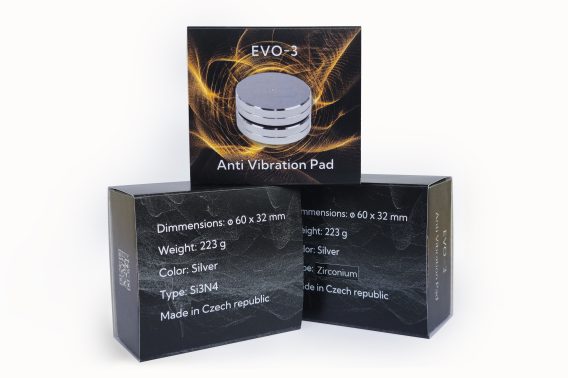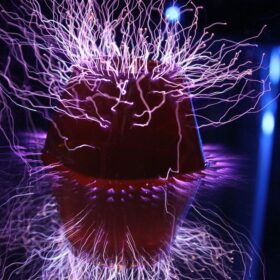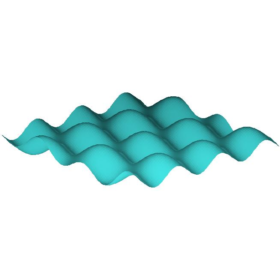EVO-3 Anti-resonance pads
The anti-resonance pad eliminates unwanted vibrations from audio components and speakers. The core consists of three evenly spaced strength spheres. Each sphere is housed in its own spherical housing.
In music, details matter. Push the boundaries of your audio setup the easy way.
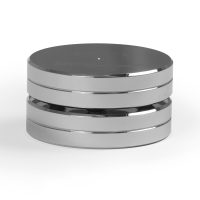
| Length | 6 cm |
| Width | 6 cm |
| Height | 3.2 cm |

| Length | 6 cm |
| Width | 6 cm |
| Height | 3.2 cm |
EVO-3 Anti-resonance pads
The body is made of high-quality dural, on which a double layer of copper and nickel is applied. The nickel is hardened by nitriding at a temperature of 600°C in a further process. The upper and lower parts are separated by three very precise hardened spheres. Each sphere moves in its own polished spherical housing. This assembly eliminates unwanted vibrations that spread in space when listening to music. It protects audio components and speakers from ambient vibrations. Installation is absolutely simple. Under audio components, usually amplifiers, preamplifiers, DA converters, we insert four or three EVO-3 pads. The pads are placed under the bottom plate of the components, not under the rubber feet. We recommend using four pads for speakers.
The evolution of the final product took more than three years of development. We conducted a number of tests of different geometries and combinations of different materials. Our experience is here, try the EVO-3.
|
They strengthen the bass and accentuate its contour, enhance spatiality, clarify the contours of instruments, and increase the transparency of vocals. They are a suitable addition rather for tube amplifiers. Maximum load 100 Kg per pad. |
|
They emphasize mid and high frequencies, enhance spatiality, clarify instrument contours, and increase vocal transparency. They are a suitable addition to transistor amplifiers. Maximum load 100 Kg per pad. |
How Do the EVO-3 Perform Specifically?
Review by Hifi-voice.com
The lower, tempo-setting frequencies in "Lovers Rock" from the self-titled album by Nigerian-British singer Helen Folasade Adu, better known as Sade (2000 | Epic | 500766 2), were noticeably punchier, more physical, more confidently contoured, and better separated with the support of zirconium. Perhaps not as voluminous, but more concentrated and perceptually precise. In contrast, silicon emphasized fullness, a sense of relaxation, and a kind of calm bubbling, enhancing the feeling of weight and richness—less defined, yet still subjectively better than when the device is simply placed "as is."
The same effect was observed in "First of May", a Bee Gees cover performed by Sarah Brightman ("The Very Best of" | 2001 | EastWest | 8573 88362-2). This track features bright, ringing highs, where the "light" setup ensured greater "crispness"—an English term that conveys a clear meaning but is somewhat difficult to translate directly. In Czech, one might describe it as a sharper chime, a more finely honed tone that stands out distinctly. The "dark" variant, on the other hand, did not bring out the highs to the same level of clarity but rather emphasized a sense of organic cohesion. Even so, there was an improvement in clarity, creating a richer and more balanced character.
The dynamics in Prokofiev's "Symphony No. 1 in D Major, Op. 25" (Sergiu Celibidache / Münchner Philharmoniker | "Symphonies 1 + 5" | 2004 | EMI | 7243 5 57854 2 8) were influenced by both sets, each in its own way. Zirconium seemed to enhance the ease with which energy surged, creating a lighter, airier presentation with greater, more physical emphasis and impact. Silicon nitride, on the other hand, emphasized fluidity, mass, and smoothness, allowing the music to hit with more power and density.
In the cinematic piece "God Particle" (Hans Zimmer | "Angels & Demons" | 2009 | Columbia | 88697520962), the zirconium pieces provided greater confidence, firmly placing each note in its position. The soundstage appeared more confidently defined and even wider, offering more air and space, making the entire musical landscape easier to interpret. Meanwhile, the ceramic models "turned up the heat," intensifying the overall experience. The result was denser, more connected, and less holographic, yet more dynamic and robust, as if presented on a larger scale.
The oboe interpretation of Telemann's "Fantasia for Flute No. 3 in B Minor" ("The Artistry of Heinz Holliger" | 1987 | Denon | DC-8006) became more defined with zirconium supports. The instrument stood out more clearly and tangibly at the center of the soundstage, offering a monitor-like precision. In contrast, the ceramic variant provided a greater sense of integration with the surroundings, with more air and a stronger ambient presence, highlighting echoes and spatial reflections.
Review by Watt-audio.sk
From the moment they were installed, it was immediately evident that their impact on sound reproduction was far from insignificant. Initially, I could hardly believe it myself, but the change was truly substantial across all sonic parameters. The most pronounced improvements were in the overall brightness and clarity of the musical scene, particularly in the midrange and treble, which are crucial carriers of musical information.
The highs gained a stronger emphasis and purity, and the overall reproduction acquired a more dynamic and faster response. Details were rendered more distinctly, with richer articulation and sharper contours. Subtle details, previously masked by more dominant elements, became more noticeable due to better definition and increased energy.
In the lower frequency range, the bass response exhibited greater control, with a clearer decay and no artificial boosting of the low-end, which can sometimes result in unwanted humming or booming. With more precise attack and decay, the bass felt faster and more aggressive, yet without losing body or coherence with the mid and high frequencies. The overall presentation became more balanced and structured, improving not only clarity but also the precision and stability of spatial imaging.
Reviews and videos
The best part is that the EVO-3 doesn't cost any unacceptable money, on the contrary - for such mechanically and materially nice workpieces, some three thousand are a great offer. With our components, they clearly and undoubtedly improved the resulting quality of the experience... There was more air, or rather the "ambient" was more noticeably present, the feeling of echoes in the space and the like...
Starting a business based on physical manufacturing in the Czech Republic is always an undertaking that deserves our admiration. Starting a business here in the high-end segment earns downright serious respect...
I had the honor of being one of the first to get my hands on the first production run of the EVO-3 anti-resonance pads. Even though I own several pads from different manufacturers, the design, quality of workmanship and most importantly the final effect is incredible for the price!
FAQ
What effect do vibrations have on audio components?
The piezo effect is one of the basic properties of silicon. Vibration changes the voltage in the crystal lattice of silicon, and this voltage affects the flow of electrons in transistors. The effect of vibrations on the properties of transistors is small, almost imperceptible in everyday life. However, if we get into a listening studio environment with a quality listening set-up, the positive change in the sound with the EVO-3 pads is audible and clear.
As a technician, I was very skeptical during the first test. I heard the change in both transistor and tube amplifiers. I started to investigate how it is possible that the character of the sound of the amplifier changes due to vibrations. Over time, after a series of tests of various designs and materials, we developed an anti-vibration pad that really works. EVO-3 will highlight the space in music and highlight background details.
Let’s realize that human hearing is our most sensitive sense. That is why the volume of sound is given in logarithmic units of Decibel. Listening loudly at 100dB (one hundred decibels) is 10,000,000,000 (ten billion) times more powerful than at 1dB (one decibel). As audiophiles, we strive to push the technical limits of what is possible to hear as much detail in recordings as possible. The details are where the emotions, color, and space in music lie. The EVO-3 pushes the boundaries of detail in any audio setup. Tested on humans.
Why do vibrations affect speakers?
Speakers, by their very nature, create vibrations that travel through the air and reach our ears. Speakers are not headphones. Sound travels from the speaker throughout the space where we are listening. Acoustic energy travels at a speed of 345 m/s in the air. Acoustic waves reflect off the walls, ceiling and floor back into the space, where their energy is added or subtracted, and we hear their sum. The behavior of sound in a closed space is dealt with by acoustics, which is not the subject of this article. It is even more complicated, since we hear frequencies from 20Hz to 20kHz, where wavelengths range from 17m to 17mm.
The speaker membrane creates energy at various frequencies that travels through the space and adds up with reflections from the surrounding walls. Speakers are also affected by the energy they generate themselves. Vibrations from the environment are transmitted to them, which are delayed and of different sizes. By placing the speakers on the EVO-3 anti-vibration pads, they gain freedom in space and their sound performance becomes breath-taking.
Imagine the sea with waves. When you place a speaker in the sea, at the height of the waves, the waves will hit it and transfer their energy to it, they will shatter against it. If you place the same speaker on a boat, it will move in harmony with the waves and no energy will shatter against it. We can imagine the same thing with the propagation of sound, only air is 1000 times lighter than water and sound waves are much faster.
From our blog
Is the term “skin effect” often arising in the audiophile world only a “voodoo fallacy”, or does this phenomenon, as described by J. C. Maxwell in 1892, really influence music reproduction?
To understand sound behaviour in closed space better, we have to get into a bit of theory.
Newsletter
We'll let you know about our participation in audio shows, new reviews and products, new places to listen to your speakers, or new posts on our blog. We won't spam you.
